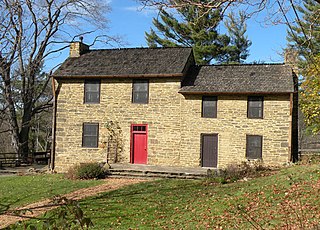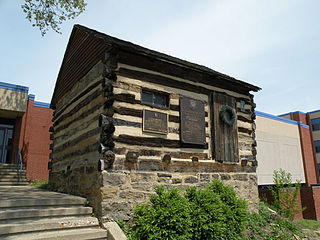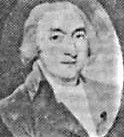
Allegheny County is a county in the Commonwealth of Pennsylvania. It is located in Southwestern Pennsylvania. As of the 2020 census, the population was 1,250,578, making it the state's second-most populous county, after Philadelphia County. Its county seat is Pittsburgh. Allegheny County is part of the Pittsburgh, PA metropolitan statistical area and the Pittsburgh media market.

The Whiskey Rebellion was a violent tax protest in the United States beginning in 1791 and ending in 1794 during the presidency of George Washington. The so-called "whiskey tax" was the first tax imposed on a domestic product by the newly formed federal government. Beer was difficult to transport and spoiled more easily than rum and whiskey. Rum distillation in the United States had been disrupted during the American Revolutionary War, and whiskey distribution and consumption increased afterwards. The "whiskey tax" became law in 1791, and was intended to generate revenue for the war debt incurred during the Revolutionary War. The tax applied to all distilled spirits, but consumption of American whiskey was rapidly expanding in the late 18th century, so the excise became widely known as a "whiskey tax". Farmers of the western frontier were accustomed to distilling their surplus rye, barley, wheat, corn, or fermented grain mixtures to make whiskey. These farmers resisted the tax. In these regions, whiskey often served as a medium of exchange. Many of the resisters were war veterans who believed that they were fighting for the principles of the American Revolution, in particular against taxation without local representation, while the federal government maintained that the taxes were the legal expression of Congressional taxation powers.

The Cumberland Presbyterian Church is a Presbyterian denomination spawned by the Second Great Awakening. In 2019, it had 65,087 members and 673 congregations, of which 51 were located outside of the United States. The word Cumberland comes from the Cumberland River valley where the church was founded.

The Mother Bethel African Methodist Episcopal Church is a historic church and congregation at 419 South 6th Street in Center City Philadelphia, Pennsylvania, USA. The congregation, founded in 1794, is the oldest African Methodist Episcopal congregation in the nation. Its present church, completed in 1890, is the oldest church property in the United States to be continuously owned by African Americans. It was designated a National Historic Landmark in 1972.

Pittsburgh Theological Seminary (PTS) is a Presbyterian graduate seminary in Pittsburgh, Pennsylvania. Founded in 1794, it houses one of the largest theological libraries in the tri-state area.
David Bradford (1762–1808) was a successful lawyer and deputy attorney-general for Washington County, Pennsylvania in the late 18th century. He was infamous for his association with the Whiskey Rebellion, and his fictionalized escape to the Spanish-owned territory of West Florida with soldiers at his tail. He was later pardoned by President John Adams for his actions. Today, his family's home in Washington, Pennsylvania is a national landmark and museum.
Washington Presbytery, of the Presbyterian Church (USA) is the association of PCUSA churches in Washington and Greene counties in Pennsylvania.

David Steele, Sr. was a Reformed Presbyterian or Covenanter minister.
William Wick was Presbyterian Minister and schoolmaster in the frontier of Washington County, Pennsylvania and the Connecticut Western Reserve in Ohio. His son, William W. Wick was a U.S. Representative from Indiana and Secretary of State of Indiana.

Woodville, also known as the Neville House or John Neville House, is a house on Washington Pike south of Heidelberg, Pennsylvania. It is significant for its association with John Neville, a tax collector whose other house was burned in the Whiskey Rebellion in 1794. The oldest portion of the house dates to 1775, with a main section built a decade later. It is one of the oldest houses in Allegheny County, preserved and restored to its original condition.

Matthew Brown was a prominent Presbyterian minister and president of Washington College and Jefferson College. Next to John McMillan, Brown was the most important figure to education in Western Pennsylvania.

Oliver Miller Homestead, site of the James Miller House, is a public museum that commemorates pioneer settlers of Western Pennsylvania. It is located in Allegheny County, Pennsylvania's South Park 10 miles (16 km) south of downtown Pittsburgh in South Park Township.

John McMillan was a prominent Presbyterian minister and missionary in Western Pennsylvania when that area was part of the American Frontier. He founded the first school west of the Allegheny Mountains, which is now known as John McMillan's Log School. He is one of the founders of Washington & Jefferson College.

Mingo Creek Presbyterian Church and Churchyard is a church and historic location in Washington County, Pennsylvania. It is located at the junction of Pennsylvania Route 88 and Mingo Church Road in Union Township, Washington County, Pennsylvania, near Courtney, Pennsylvania. It is a member of the Washington Presbytery.

The history of Washington & Jefferson College begins with three log cabin colleges established by three frontier clergymen in the 1780s: John McMillan, Thaddeus Dod, and Joseph Smith. The three men, all graduates from the College of New Jersey, came to present-day Washington County to plant churches and spread Presbyterianism to what was then the American frontier beyond the Appalachian Mountains. John McMillan, the most prominent of the three founders because of his strong personality and longevity, came to the area in 1775 and built his log cabin college in 1780 near his church in Chartiers. Thaddeus Dod, known as a keen scholar, built his log cabin college in Lower Ten Mile in 1781. Joseph Smith taught classical studies in his college, called "The Study" at Buffalo.

John McMillan's Log School is a landmark log building in Canonsburg, Pennsylvania that was the site of John McMillan's frontier Latin school during the 1780s. It is a symbol of Canonsburg and Canonsburg's educational tradition. In 1930, The Pittsburgh Press said that the building was "viewed by the pioneers with even more reverence than Pittsburgh now view the towering Cathedral of Learning in Oakland." It is one of the oldest buildings in Western Pennsylvania. It is the "oldest educational building west of the Allegheny Mountains."

The Reformed Presbyterian Church of Scotland is a small, Scottish, Presbyterian church denomination. Theologically they are similar to many other Presbyterian denominations in that their office-bearers subscribe to the Westminster Confession of Faith. In practice, they are more theologically conservative than most Scottish Presbyterians and maintain a very traditional form of worship. In 1690, after the Revolution, Alexander Shields joined the Church of Scotland, and was received along with two other ministers. These had previously ministered to a group of dissenters of the United Societies at a time when unlicensed meetings were outlawed. Unlike these ministers, some Presbyterians did not join the reconstituted Church of Scotland. From these roots the Reformed Presbyterian Church of Scotland was formed. It grew until there were congregations in several countries. In 1876 the majority of Reformed Presbyterians, or RPs, joined the Free Church of Scotland, and thus the present-day church, which remained outside this union, is a continuing church. There are currently Scottish RP congregations in Airdrie, Stranraer, Stornoway, Glasgow, and North Edinburgh. Internationally they form part of the Reformed Presbyterian Communion.

Laurel Hill Presbyterian Church is a Presbyterian church in Dunbar, Pennsylvania. One of the first Presbyterian churches west of the Allegheny Mountains, it was founded in 1772 along with it’s sister Churches Tyrone, Middle, Sewickley, and United Presbyterian Churches. The original church was a simple log structure and was built by Scotch-Irish immigrants.
Thomas Nairn was a controversial Scottish Presbyterian minister. Although he served in several Presbyterian denominations perhaps his most important contribution to church history was his role in setting up the organisation which eventually became the Reformed Presbyterian Church. Although his stay with that religious community was relatively short he was acknowledged, by right of his valid ordination, to have the authority, along with John M'Millan, to form a legitimate presbytery and in so doing to be able to ordain others to the offices of the church. Before Nairn's arrival M'Millan had for more than 36 years been the only minister in what was essentially a small denomination known as the United Societies. Nairn had previously been a minister in the Associate Presbytery of the First Seceders, although he started and ended his days in the Church of Scotland.

Thomas Ledlie Birch (1754–1828) was a Presbyterian minister and radical democrat in the Kingdom of Ireland. Forced into American exile following the suppression of the 1798 rebellion, he wrote A Letter from An Irish Emigrant (1799).

















